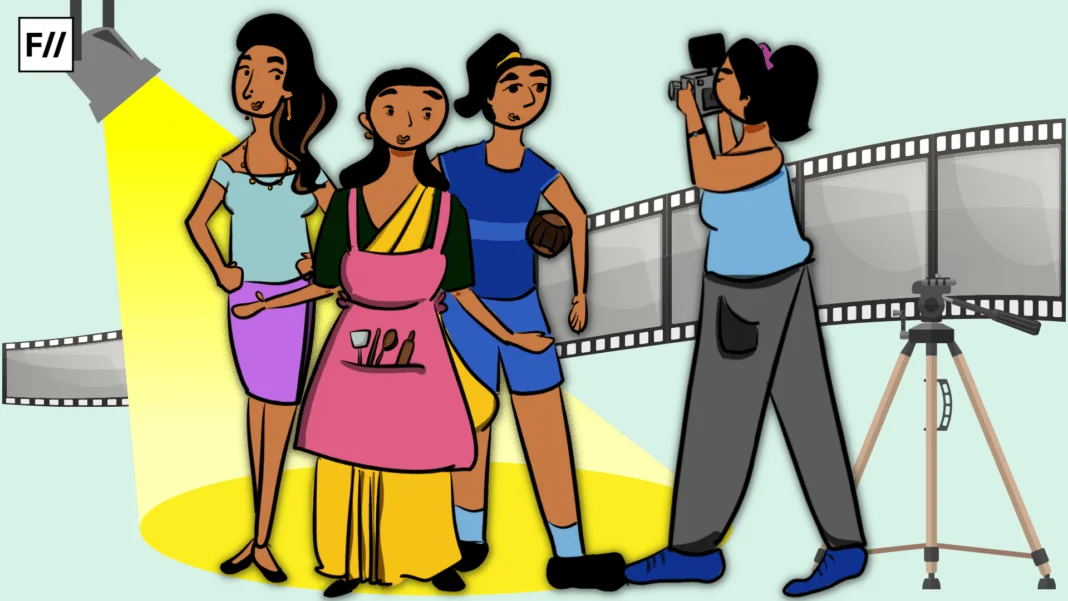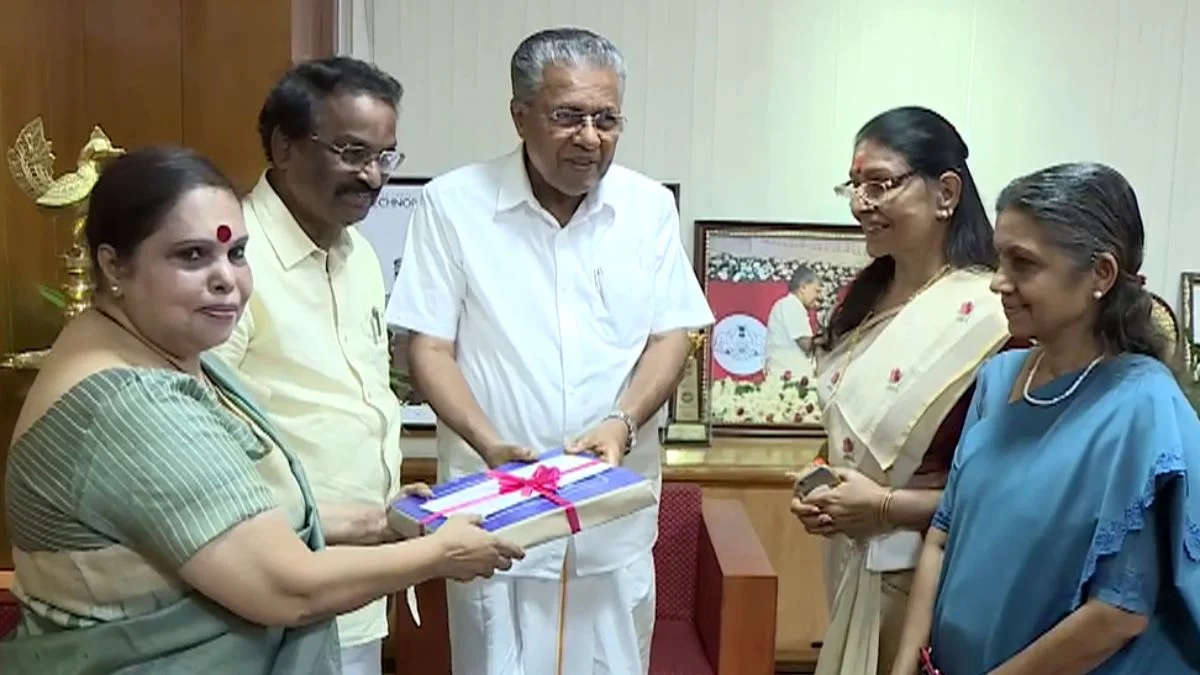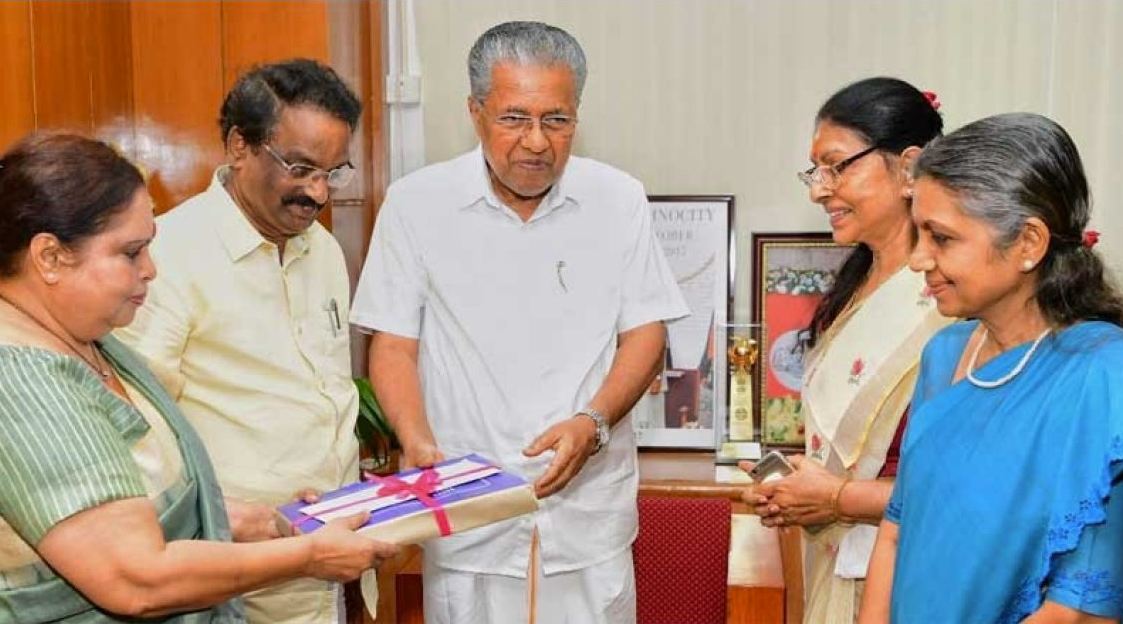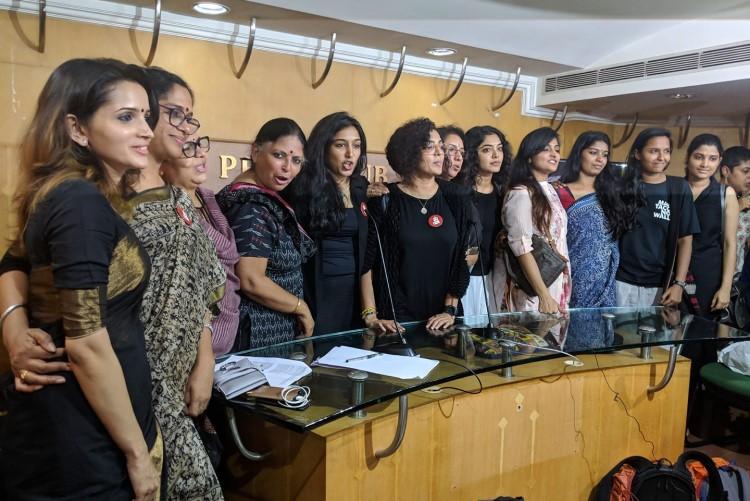In Section VI of her recommendations in the Hema Committee Report, committee member K. B. Valsalakumari IAS, recommends that suggestions be solicited to encourage gender justice in the content of Malayalam cinema. She notes how cinema projects a ‘distorted demography‘ which gives the impression to people, especially children and youth, that women’s issues do not matter or are not significant enough to be portrayed on screen’ (p. 293).
She points out that women’s conventional portrayals on screen are heavily biased towards the domestic, and that young women are frequently sexualised.
She points out that women’s conventional portrayals on screen are heavily biased towards the domestic, and that young women are frequently sexualised. Valsalakumari further notes that there are few transformative roles for women onscreen, especially in leadership positions, or those that elicit respect.
Exemplary figures, when present, are depicted as weak failures. Women are often commodified; she especially criticises ‘item numbers.‘ Finally, she notes that female actors face a number of violations when they have to enact intimacy on screen. Cinema, in other words, glorifies the subordination of women.
All this urges her to say that ‘ . . .a historical rectification . . .is the need of the hour and this can be accomplished by de-schooling what has been taught so far through written words, images, signs and their significations.’ Valsalakumari singles out ‘visual media‘ as the potential site of this de-schooling because of its enormous potential to ‘influence minds and hearts‘; she argues that ‘a world with equity where both men and women are treated equally is possible and that it can be attained if we attempt it consciously‘ (p. 281).
Valsalakumari then puts forward several suggestions to mainstream gender justice in the content of films:
1. Enhance the visibility of women and girls on screen
2. Show more instances of women in power and how they can make a difference
3. Initiate gender awareness programmes
4. Redefine masculinity and femininity in films
5. Require certification to ensure that nothing that glorifies gender injustice has been portrayed
Countering onscreen misogyny without censorship
While regulating cinematic content is helpful to shape gender representation and gender justice in films, there is also the real possibility that some of the above steps might strengthen pro-censorship positions in cinema. It is somewhat reductive to equate the worth of cinematic content with its didactic value. Besides being problematic in itself, such a perceived pro-censorship approach may actually provide vested interests with an excuse to further attack the Hema Committee recommendations as essentially prudish censorship that devalues creativity.
However, the very real issue of burgeoning misogyny in Malayalam cinema might be mitigated without conceding ground to censorship or celebrating moralising narratives.
However, the very real issue of burgeoning misogyny in Malayalam cinema might be mitigated without conceding ground to censorship or celebrating moralising narratives.
Firstly, it is important to recognise that rather than creating misogyny, Malayalam cinema distorts and exaggerates the already existing misogyny in the society on screen.
A case in point would be the representation of rape in Malayalam cinema since the mid-20th century. Rape is as valid a cinema subject as any. But in mainstream commercial Malayalam films, rape has evolved its own film form, which, in practice, is made with the pleasure of the male spectator in view, and foregrounds the abjection of the woman being assaulted. Such abjection is entirely voyeuristic, gratuitous, and unnecessary to emphasise the violence of the rape act, or to condemn it.
Rape as a narrative element need not be censored, but, the set, misogynist and disempowering patterns of its onscreen representation need to be dislodged.
Similarly, while ‘item numbers‘ criticised by Valsalakumari may, on the one hand, be seen as exploitative or allegedly even pornographic, item numbers may be framed and shot in ways empowering to women. Item numbers remain one of the few avenues in film where female performers earn well. Female sexuality is an appropriate subject for cinema and need not be censored on the grounds of misogyny or pornography.
Intimacy coordinators to oversee filming of intimate scenes
The connection that Valsalakumari makes between disempowering content and the difficulties that female actors face in enacting intimate scenes is a valid issue raised in numerous places in the HCR. A conservative response to such a quandary is to recommend “safe” or “modest” content which is tantamount to censoring. However, there are other possible responses that are not misogynistic or disempowering, nor in need of censorship.
The Women in Cinema Collective (WCC, 2022) itself has pointed to the need to hire ‘intimacy coordinators‘ responsible with ensuring that no violations are perpetrated during the filming of intimate scenes.
The Women in Cinema Collective (WCC, 2022) itself has pointed to the need to hire ‘intimacy coordinators‘ responsible with ensuring that no violations are perpetrated during the filming of intimate scenes. Along with pushing for trained intimacy coordinators, such bodies as the Swedish Film and TV Producers Association and the Swedish Union for Performing Arts and Film, and the Screen Actors Guild—American Federation of Television and Radio Artists, have guidelines to ensure the safety of actors while performing intimate scenes.
One way to ensure the safety of actors in intimate scenes would be to create a broad set of guidelines, to be drawn in consultation with WCC and other bodies, to ensure safe and respectful filmmaking. The existing Monitoring Committee should be reconstituted to ensure a fair and diverse set of voices in it, including WCC members.
There should be a strong push to make intimacy coordinators a necessary presence on film sets. Intimacy coordinators should be part of the production budget. They shall work with directors to define what constitutes ‘intimate scenes,‘ help shape the content, oversee the filming of intimate scenes in ways that are respectful of the actors’ rights and ensure their security, and also review film publicity.
Intimacy coordinators not only create another area of crucial employment within the industry; their necessary presence would also potentially help to professionalise soft porn or adult films made for online or offline viewership. Best practices in the filming of intimate scenes will produce better representations on screen while ensuring the safety of actors.
Valsalakumari’s suggestions that women should be granted more screen time and presence, and greater variety of roles, may be put into practice by creating content that expresses gender in all of its variety rather than the extremes of demeaning representations of femininity and misleading portrayals of masculinity.
Instead of ascribing certain morally encoded roles for women, which would impose a form of censorship, aspiring film-makers should consider the diverse and multiple ways in which sexual intimacy, physical intimacy, sexualities, sexual desire, violence, and gender power can be depicted in cinema, without relying on stultified stereotypical models, but, instead, represent the wide gamut of true human experience.
Gender Justice is not political correctness
It should be noted that the demand for gender justice onscreen does not mean political correctness that could stymie creativity. Malayalam films should aim for a truer integration and representation of women’s lives. The following measures might indicate a corrective turn.
(a) provide trainings and workshops aimed at aspiring and practising film professionals to produce varying representations of gender and sexuality apart from those mediated through the lens of voyeurism. Collaborations should be encouraged between media and gender researchers, academics , and professionals who have made gender-just films to design such workshops. These workshops may be offered in film schools, colleges and universities, and at film festivals and film societies.
Malayalam films should aim for a truer integration and representation of women’s lives.
(b) encourage more women to produce gender-just film content by offering film-making grants to women directors and script-writers. The many serious complaints raised by the women directors who received the existing women empowerment awards must be examined seriously and shortcomings rectified quickly.

(c ) hire and train, in the longer run, more women in the technical side of production and post production. Positions such as lighting, VFX, animation, editing, sound design etc. may be pitched as creative and artistic fields. These currently male-dominated fields are potentially areas where artistically oriented and talented women can flourish.
(d) recruit and train more girls and women into the production and post-production fields by loaning digital cameras, offering classes for scripting and acting, and mentorship in production and post production work.
(e) encourage the funding of film content that diversifies and complicates set narratives of gender and sexuality. Better representation of Malayali life on screen needs more nuanced representation of the many layers of social reality, including the lives of marginalised social groups to rectify the inequitable representations of caste, sexuality, skin colour, age, religion etc. For example, older women often get stuck in mother roles. Darker skinned women get typecast in side roles or servant roles etc.
(f ) set up a gender-rating system for Malayalam film scripts/screenplays in conjunction with WCC. Films must be rated along a spectrum of gender transformative (5), gender progressive (4), gender essentialist (3), gender blind (2), and gender hostile (1). Filmmakers should be encouraged to score a 4 or 5. This can be a self-rating that filmmakers are required to do at the time of title registration. It is recommended to self-rate precisely in the interest of avoiding censorship.







